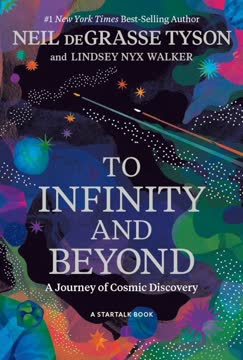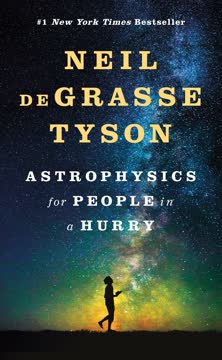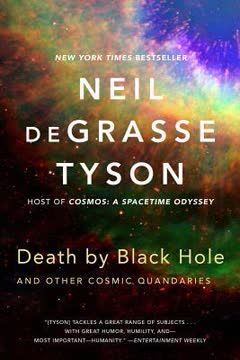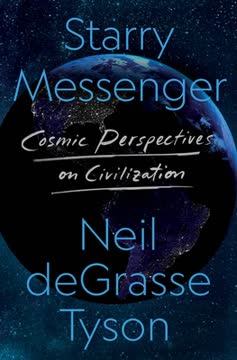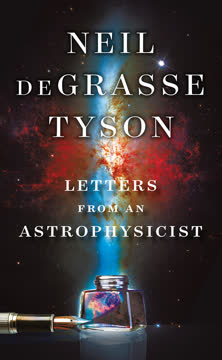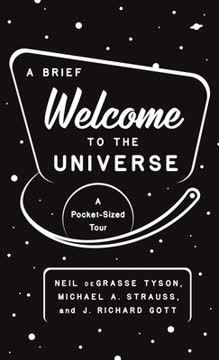Key Takeaways
1. Cosmic Discovery: A Journey Beyond Earthly Limits
Slowly but surely, a new universe emerged—one roiling with molecules, lurking with monstrous black holes, snaking with voids and galaxies of every size and shape, and hinting at untold mysteries yet to explore.
Humanity's quest for knowledge. From ancient myths to modern science, humans have always sought to understand the cosmos. This journey of discovery has shattered old beliefs, revealing a universe far grander and stranger than we ever imagined. The book invites readers to embark on this odyssey, exploring the vastness of space and the humbling truths it holds.
Leaving the nest. Overcoming Earth's gravity has been a monumental achievement, enabling us to explore our solar system and beyond. The Wright brothers' first flight and the Apollo 11 Moon landing stand as testaments to human ingenuity and determination. Space probes like Voyager 1 and the James Webb Space Telescope continue to expand our understanding of the universe, sending back images and data that challenge our assumptions and inspire awe.
Unending quest. The cosmic odyssey is a continuous process of questioning, discovering, and revising our understanding of the universe. Each new revelation leads to more mysteries, driving us to push the boundaries of knowledge and explore the unknown. This journey is not just about scientific advancement but also about acknowledging our place in the vast cosmos.
2. The Sun: A Nuclear Engine and Weather Maker
Thermonuclear fusion—the contained nuclear bombs that continuously detonate within the Sun’s hot, dense core—is the only defense against its own gravity, the only thing preventing its collapse.
The Sun's power source. The Sun, a seemingly constant presence in our sky, is a dynamic nuclear reactor. Thermonuclear fusion in its core converts hydrogen into helium, releasing immense energy that sustains life on Earth. This process also creates a constant outward pressure that counteracts the Sun's own gravity, preventing its collapse.
Solar weather. The Sun's activity, including solar flares and coronal mass ejections (CMEs), can have significant impacts on Earth. These events can disrupt power grids, communication systems, and even pose risks to astronauts. Understanding solar weather is crucial for protecting our technology and ensuring our safety in space.
Parker Solar Probe. Missions like the Parker Solar Probe are helping us to better understand the Sun's corona and the origins of solar wind. By venturing closer to the Sun than ever before, these probes are providing valuable data that could help us predict and mitigate the effects of solar storms. The Sun's influence extends far beyond our planet, shaping the entire solar system.
3. Rocky Planets: From Barren Worlds to Potential Havens
Mercury remains the least explored of the seven classical wanderers.
Mercury's challenges. Mercury, the innermost planet, presents unique challenges for exploration due to its proximity to the Sun and its extreme temperatures. Despite its harsh conditions, Mercury holds secrets about the early solar system and the formation of rocky planets. Missions like MESSENGER have revealed evidence of water ice in permanently shadowed craters, challenging our assumptions about this seemingly barren world.
Venus: A cautionary tale. Venus, once potentially habitable, now serves as a stark warning about the dangers of a runaway greenhouse effect. Its scorching surface temperatures and toxic atmosphere highlight the importance of maintaining a stable climate on Earth. Studying Venus can provide valuable insights into the factors that make a planet habitable and the consequences of environmental degradation.
Mars: The red hope. Mars, with its potential for past habitability, remains the most promising candidate for future human colonization. While it currently lacks a thick atmosphere and liquid surface water, evidence suggests that Mars once had a more Earth-like environment. Terraforming Mars, though a daunting task, could potentially create a new home for humanity beyond Earth.
4. Gas Giants: Swirling Storms and Hidden Oceans
Caught in the orbital carousel around our own Sun, eight planets, hundreds of moons, and countless comets and asteroids whirl and twirl on paths choreographed by the forces of gravity.
Jupiter's dominance. Jupiter, the largest planet in our solar system, is a gas giant with a powerful gravitational pull. Its Great Red Spot, a centuries-old storm, is a testament to the planet's dynamic atmosphere. Jupiter also plays a crucial role in protecting the inner solar system by deflecting asteroids and comets that might otherwise threaten Earth.
Saturn's rings and moons. Saturn, famous for its stunning ring system, is another gas giant with a complex system of moons. One of these moons, Titan, possesses a thick atmosphere and liquid methane oceans, making it a unique and potentially habitable world. The Cassini-Huygens mission provided valuable insights into Saturn and its moons, revealing their diverse and fascinating features.
Ice giants: Uranus and Neptune. Uranus and Neptune, the ice giants, are the most distant planets in our solar system. These worlds are composed primarily of water, methane, and ammonia ice, giving them a distinct bluish hue. Voyager 2's flybys of Uranus and Neptune provided our only close-up views of these mysterious planets, revealing their unique atmospheric features and icy compositions.
5. Space: More Than Nothingness, a Quantum Realm
We tend to define space not by what it is and has, but by what it is not and doesn’t have.
Challenging the void. Space is often perceived as an empty void, but this is a misconception. Even in the vast expanses between galaxies, space is filled with particles, energy fields, and the subtle influence of gravity. The concept of "true nothingness" is elusive, as even the emptiest regions of space are teeming with quantum activity.
Quantum fluctuations. Quantum physics reveals that even in a vacuum, virtual particles constantly pop into and out of existence. These fleeting particles, governed by Heisenberg's uncertainty principle, demonstrate that space is not truly empty but rather a dynamic realm of quantum fluctuations. This challenges our classical understanding of emptiness and highlights the strangeness of the quantum world.
The aether's demise. The historical belief in a luminiferous aether, a medium through which light was thought to propagate, was disproven by the Michelson-Morley experiment. This experiment demonstrated that the speed of light is constant, regardless of the observer's motion, leading to Einstein's theory of special relativity and a new understanding of space as a dynamic and interconnected fabric.
6. Light: Wave, Particle, and Cosmic Messenger
The reason the Sun looks yellow is the same reason the sky looks blue.
Dual nature of light. Light exhibits both wave-like and particle-like properties, a concept known as wave-particle duality. This seemingly contradictory behavior has been a subject of debate for centuries, with scientists like Newton and Huygens championing opposing views. The modern understanding of light as both a wave and a particle highlights the complexity and strangeness of the quantum world.
Spectroscopy's power. Spectroscopy, the analysis of light's spectrum, is a powerful tool for understanding the composition and properties of celestial objects. By studying the wavelengths of light emitted, absorbed, or reflected by stars, planets, and galaxies, we can determine their chemical makeup, temperature, and motion. Spectroscopy has revolutionized our understanding of the universe, allowing us to probe the secrets of distant objects.
Cosmic messengers. Light carries information across vast distances, acting as a messenger from the past. When we observe distant stars and galaxies, we are seeing them as they were millions or even billions of years ago. This allows us to study the evolution of the universe and glimpse into its distant past.
7. Gravity: Shaping Spacetime and Defining Orbits
We call this state of motion an orbit.
Newton's apple and the cannonball. The story of Isaac Newton and the falling apple illustrates the universal nature of gravity. Newton realized that the same force that pulls an apple to the ground also keeps the Moon in orbit around Earth. This insight led to his law of universal gravitation, which describes the force of attraction between any two objects in the universe.
Spacetime curvature. Einstein's theory of general relativity revolutionized our understanding of gravity, describing it not as a force but as a curvature of spacetime caused by mass and energy. Massive objects warp the fabric of spacetime, influencing the motion of other objects in their vicinity. This curvature explains the orbits of planets around stars and the bending of light around massive objects.
Lagrange points. Lagrange points are special locations in space where the gravitational forces of two celestial bodies balance each other out. These points offer stable locations for parking satellites and space telescopes, allowing them to maintain their positions with minimal fuel consumption. Lagrange points are a testament to the intricate interplay of gravity and orbital mechanics.
8. Time: Relative, Warped, and a Dimension to Explore
If you did not already know that Earth orbits the Sun, and not the other way around, you would have a hard time discovering that truth for yourself.
Relativity's implications. Einstein's theories of relativity have profound implications for our understanding of time. Special relativity demonstrates that time is relative, depending on the observer's motion. General relativity shows that gravity also affects time, causing it to slow down in regions of strong gravitational fields.
Time dilation. Time dilation, a consequence of relativity, means that time passes differently for observers in different frames of reference. Astronauts traveling at high speeds experience time more slowly than people on Earth. This effect, though small, has been experimentally verified and is crucial for the operation of GPS satellites.
Time travel possibilities. While time travel to the past remains a theoretical possibility, the laws of physics do not entirely rule it out. Concepts like wormholes and warp drives offer potential pathways for faster-than-light travel and time manipulation, though they require exotic matter and face significant technological challenges. The exploration of time travel continues to fascinate scientists and inspire science fiction writers.
9. Black Holes: Gravity's Ultimate Frontier
The rocket worked perfectly except for landing on the wrong planet.
Gravity's extreme. Black holes, regions of spacetime with such intense gravity that nothing, not even light, can escape, represent the ultimate frontier of gravitational physics. These cosmic behemoths are formed from the collapse of massive stars and warp spacetime to an extreme degree. Black holes challenge our understanding of the universe and offer a glimpse into the most extreme conditions imaginable.
Event horizon. The event horizon, the boundary of a black hole, marks the point of no return. Once an object crosses the event horizon, it is forever trapped within the black hole's gravitational pull. The event horizon represents a one-way ticket to the unknown, a region where the laws of physics as we know them may break down.
Warped spacetime. Black holes provide a natural laboratory for testing Einstein's theory of general relativity. The extreme gravity around black holes warps spacetime, causing time dilation and bending light. Observations of black holes and their effects on surrounding matter provide valuable insights into the nature of gravity and the structure of the universe.
10. The Universe: Expanding, Evolving, and Teeming with Mysteries
We began as wanderers, and we are wanderers still.
The Big Bang. The Big Bang theory, supported by a wealth of evidence, describes the origin of the universe from a hot, dense state approximately 13.8 billion years ago. The expansion of the universe, the cosmic microwave background radiation, and the abundance of light elements all provide strong evidence for the Big Bang. The Big Bang marks the beginning of space, time, and everything we know.
Dark energy and dark matter. Dark energy, a mysterious force driving the accelerated expansion of the universe, and dark matter, an invisible substance that makes up a significant portion of the universe's mass, are two of the biggest mysteries in modern cosmology. These enigmatic entities challenge our understanding of the universe and drive ongoing research to unravel their nature.
The search for life. The search for extraterrestrial life is one of the most compelling endeavors in modern science. With billions of Earth-like planets potentially orbiting stars in our galaxy, the possibility of life beyond Earth is tantalizing. The discovery of biosignatures in exoplanet atmospheres could provide the first evidence of life beyond our planet, revolutionizing our understanding of the universe and our place within it.
Last updated:
FAQ
What is To Infinity and Beyond: A Journey of Cosmic Discovery by Neil deGrasse Tyson about?
- Cosmic journey overview: The book takes readers on an exploration from Earth to the farthest reaches of the universe, blending scientific history, modern discoveries, and philosophical questions about our place in the cosmos.
- Human curiosity and discovery: It traces humanity’s evolving understanding of the universe, highlighting how myths and misconceptions were overcome through science, technology, and courage.
- Accessible science narrative: Tyson intertwines stories of people, planets, stars, and spacecraft, making complex astrophysical concepts understandable and engaging.
- Invitation to wonder: The book encourages readers to rethink assumptions and embrace the vast unknown, inspiring a personal revolution in cosmic understanding.
Why should I read To Infinity and Beyond by Neil deGrasse Tyson?
- Bridging science and culture: Tyson’s approachable style demystifies complex topics, connecting rigorous astrophysics with engaging storytelling and cultural references.
- Correcting popular myths: The book challenges and clarifies common misconceptions about space, physics, and space travel, helping readers develop a scientifically accurate worldview.
- Inspiring curiosity and humility: It fosters a sense of wonder and humility about humanity’s place in the universe, encouraging scientific inquiry and openness to new discoveries.
- Current and future perspectives: The narrative includes recent developments and future possibilities in space exploration, making it relevant for today’s readers.
What are the key takeaways from To Infinity and Beyond by Neil deGrasse Tyson?
- Comprehensive cosmic overview: The book covers the history, science, and mysteries of space, from Earth’s atmosphere to black holes and time travel.
- Scientific concepts explained: Readers gain clear explanations of gravity, orbital mechanics, rocket science, relativity, quantum mechanics, and the expanding universe.
- Debunking misconceptions: Tyson addresses and corrects Hollywood myths and common misunderstandings about space, light, and sound.
- Human spirit of exploration: The narrative highlights the challenges, triumphs, and ongoing quest for knowledge that define humanity’s relationship with the cosmos.
How does Neil deGrasse Tyson explain gravity and orbital mechanics in To Infinity and Beyond?
- Newton’s unifying insight: Tyson describes how Newton realized gravity governs both falling objects and celestial orbits, unifying terrestrial and celestial mechanics.
- Orbit as continuous free fall: Objects like the Moon and the International Space Station are in perpetual free fall around Earth, moving fast enough to keep missing the surface.
- Escape velocity and trajectories: The book explains how reaching a certain speed allows objects to leave Earth’s gravitational influence, a key concept for space travel.
- Gravity assists and rocket launches: Tyson discusses how gravity assists are used in space missions and the challenges rockets face in overcoming Earth’s gravity.
What does To Infinity and Beyond by Neil deGrasse Tyson reveal about Earth’s atmosphere and its layers?
- Five atmospheric layers: The book details the troposphere, stratosphere, mesosphere, thermosphere, and exosphere, explaining their unique features and roles.
- Temperature and pressure: Tyson explains how temperature and air pressure vary with altitude, and why humans don’t feel the immense pressure at sea level.
- Greenhouse effect: The narrative covers how certain atmospheric molecules trap heat, making life possible on Earth.
- Boundary of space: The Kármán line is introduced as a conventional, though fuzzy, boundary between Earth’s atmosphere and outer space.
How does Neil deGrasse Tyson address the nature of space and common misconceptions in To Infinity and Beyond?
- Space is not empty: Tyson explains that space is filled with particles, virtual particles, and energy fields, challenging the idea of a perfect vacuum.
- Sound and silence in space: The book clarifies that sound cannot travel in space due to the lack of a medium, debunking Hollywood depictions of noisy space battles.
- Gravity and weightlessness: Tyson explains that astronauts experience weightlessness due to free fall, not the absence of gravity, and that gravity extends infinitely.
- Spacecraft maneuvers: The book critiques inaccurate portrayals of spacecraft movement, emphasizing the real physics of thrusters and momentum in space.
What are the key scientific concepts and physics principles explained in To Infinity and Beyond by Neil deGrasse Tyson?
- Nature of space and vacuum: Tyson discusses quantum fluctuations, virtual particles, and why true nothingness doesn’t exist in our universe.
- Wave-particle duality of light: The book covers the historical debate and modern understanding that light behaves as both a wave and a particle.
- Relativity and spacetime: Tyson explains Einstein’s theories, including how gravity warps spacetime, time dilation, and the concept of worldlines.
- Rocket science fundamentals: The narrative details the rocket equation, fuel requirements, and the physics behind launching payloads into space.
How does To Infinity and Beyond by Neil deGrasse Tyson explain the formation and features of the Moon?
- Giant-impact hypothesis: Tyson describes how the Moon likely formed from debris after a Mars-sized protoplanet collided with early Earth.
- Geochemical evidence: The book presents evidence from lunar rocks and the Moon’s small iron core, supporting the impact theory.
- Tidal locking and dynamics: Tyson explains how the Moon’s rotation matches its orbit, always showing the same face to Earth, and how it stabilizes Earth’s tilt.
- Long-term evolution: The narrative discusses how the Moon is slowly receding and how Earth’s days are lengthening over time.
What does Neil deGrasse Tyson say about the retrograde motion of planets in To Infinity and Beyond?
- Optical illusion explained: Retrograde motion is described as an apparent reversal in a planet’s path, caused by the relative motions of Earth and other planets.
- Orbital speed differences: Tyson explains that inner planets like Mercury orbit faster than Earth, leading to frequent retrograde appearances.
- Historical misconceptions: The book covers how ancient astronomers misinterpreted retrograde motion, leading to complex geocentric models.
- Heliocentric clarification: Copernicus and Galileo’s work is highlighted for providing the correct, Sun-centered explanation.
How does To Infinity and Beyond by Neil deGrasse Tyson explore the nature of light and its scientific history?
- Wave vs. particle debate: Tyson recounts the historical debate between Huygens’s wave theory and Newton’s particle theory of light.
- Modern wave-particle duality: The book explains that light behaves as both a wave and a particle, a concept fundamental to quantum physics.
- Key experiments and discoveries: Young’s double-slit experiment and Einstein’s photoelectric effect are discussed as pivotal moments in understanding light.
- Demise of the aether: Tyson explains how the Michelson-Morley experiment disproved the need for a luminiferous aether, leading to modern electromagnetic theory.
What insights does Neil deGrasse Tyson provide about black holes and gravitational waves in To Infinity and Beyond?
- Black hole fundamentals: Tyson explains black holes as regions where gravity is so strong that not even light can escape, defined by the event horizon.
- Detection and imaging: The book covers the first confirmed black hole discovery and the imaging of the supermassive black hole in galaxy M87.
- Gravitational waves: Tyson discusses the prediction and detection of gravitational waves, ripples in spacetime caused by massive cosmic collisions.
- Relativity and time dilation: The narrative explores how time slows near black holes and highlights Kip Thorne’s work and its influence on popular culture.
How does Neil deGrasse Tyson address the search for extraterrestrial life and exoplanets in To Infinity and Beyond?
- Exoplanet discoveries: Tyson details the detection of thousands of exoplanets, including Earth-sized worlds in habitable zones.
- Biosignatures and technosignatures: The book explains how spectroscopy can detect atmospheric gases and chemical signs of life or technology on distant planets.
- Challenges of interstellar travel: Tyson discusses the immense distances, technological hurdles, and ethical challenges of reaching exo-Earths.
- Human vs. robotic exploration: The narrative contrasts the creativity of human explorers with the practicality of robotic missions in the search for life.
What are the best quotes from To Infinity and Beyond by Neil deGrasse Tyson and what do they mean?
- On boundaries and definitions: Tyson uses analogies, such as the boundary between your thumb and forefinger, to illustrate the fuzzy nature of scientific definitions like the edge of space.
- On cosmic humility: Memorable quotes emphasize the vastness of the universe and humanity’s small but significant place within it, inspiring humility and wonder.
- On scientific inquiry: Tyson’s words encourage readers to question assumptions, embrace uncertainty, and pursue knowledge with curiosity and courage.
- On the future of exploration: The book’s quotes often reflect optimism about humanity’s potential to explore, understand, and thrive in the cosmos.
Review Summary
To Infinity and Beyond receives mostly positive reviews for making complex astronomical concepts accessible and engaging. Readers praise Tyson's clear explanations, humor, and ability to inspire wonder about the cosmos. Many appreciate the pop culture references and debunking of sci-fi myths. Some critics find the organization confusing or the humor excessive. Overall, reviewers recommend it as an enjoyable introduction to astronomy and cosmology, suitable for beginners and space enthusiasts alike.
Similar Books

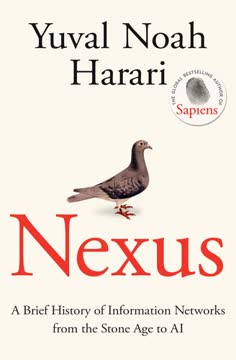
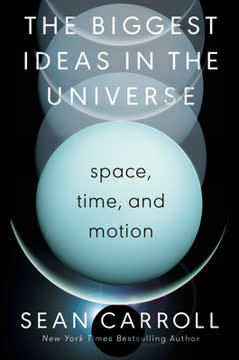
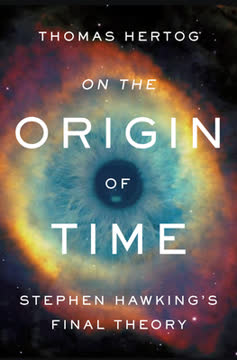
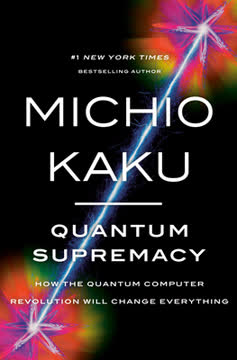

Download PDF
Download EPUB
.epub digital book format is ideal for reading ebooks on phones, tablets, and e-readers.
